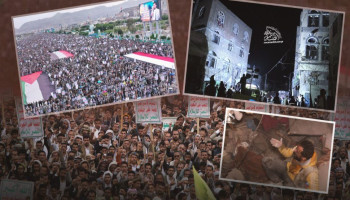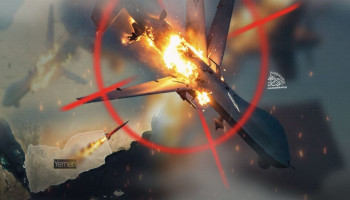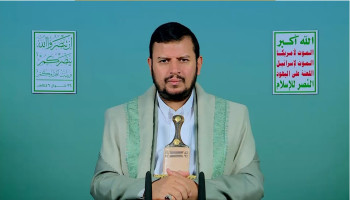Grounded in a historical and present reality supported by countless examples, Yemen has wielded its sword of strength in the face of Western power. From the earliest hours of the al-Aqsa flood conflict, Yemen stood unwavering in support of Palestine and Gaza, refusing to resort to the ineffective language of political appeals or diplomatic pleas. Yemen understands that stolen rights were seized through force, and—like the world at large—it knows that only force can restore them. Only when the balance of power is restored can political solutions be entertained, not as a means to reclaim lost rights but to secure them. This clear and direct principle echoes throughout the speeches and statements of Sayyid Abdul-Malik Badruldeen al-Houthi, encapsulating the Quranic vision for managing conflict in the defense of the oppressed.
Since the start, when the world was caught off guard, the Yemenis found themselves in the heart of the Flood battle. The events of October 7 did not shock Yemen in the true sense; instead, they presented an opportunity to escalate the confrontation with the enemy, advancing an ongoing struggle that has spanned for years.
Yemen at the Core of the Conflict
Given the prevailing conditions, Yemen was already enduring a devastating war, orchestrated by a U.S.-led international coalition and described as one of the fiercest wars of modern times. In such a context, Yemen could have justified avoiding further involvement in the Palestinian cause. Still, it chose otherwise—taking up the highest level of support and putting forth its greatest efforts. In doing so, Yemen dismissed any excuses and placed a moral obligation on the broader Muslim world, offering a profound example of human solidarity. A review of Sayyid Abdul-Malik’s speeches, especially those preceding the battle, highlights the importance of the Palestinian cause to Yemen’s worldview, driven by faith and humanitarian values.
In his speech on International Quds Day in 1444 AH, Sayyid Abdul-Malik said:
> "We operate from a Quranic foundation with full faith and confidence. The enemy’s claim that our support for Palestine is due to Iranian influence is false, slanderous, and an attempt to distort our stance. Iran, too, stands with Palestine from a position of faith, ideology, and religion. The free people of the world, including those in Palestine, act from the same place. We move from a Quranic perspective, which unites us with the free peoples of our nation. The Zionist enemy, backed by the U.S. and the West, targets our people, occupies our lands, kills innocents, and steals resources. How can anyone suggest we embrace the hand that strikes us, mocks our principles, and fights our faith?”
This ethical stance is clear. But when we consider material resources and military capabilities, the discussion takes on a new dimension.
Developing Military Capabilities
In the early stages of the war on Yemen, much of the Yemeni army’s strategic arsenal, including Soviet-era missiles, air defense systems, and warplanes, was destroyed. For nine years, Yemen faced the challenge of acquiring the necessary war equipment. Early efforts at production yielded near-zero results. However, Yemen’s experience was guided by faith, making it unique and worthy of reflection. This approach sparked a revolution in Muslim consciousness about how to confront their primary enemy—Zionism, backed by the U.S., Britain, and Israel—which perpetually confronts imbalances of power in every conflict.
When the Palestinian resistance issued its call for support on the morning of October 7, Yemen’s armed forces did not view it as an additional or separate conflict. They had been preparing spiritually for such a confrontation for years. Thus, this support is not an added burden but a natural progression in an ongoing struggle, limited only by the available resources.
Sayyid Abdul-Malik explained Yemen’s support in no uncertain terms:
> "We continuously work to develop our military capabilities. When we decide to act at a certain level, it means we have the necessary resources to make that decision. We are already preparing for future stages, including the fifth and sixth phases, with sensitive and impactful options. For us, there are no red lines, except for two:
>
> 1. Our ethical and religious principles, which guide our actions.
> 2. The availability of resources and capabilities."
Thus, the availability of weapons and ammunition does not determine whether Yemen engages in conflict or not but rather speeds up the ongoing battle. The challenges of acquiring these tools are not new—they echo those faced during the nine-year war with the U.S.-Saudi coalition, where Yemenis repeatedly experienced Allah's support. This has been witnessed on battlefields across 40 domestic fronts and regional extensions deep within Saudi and Emirati territory.
Between 2021 and 2023, Yemen’s armed forces focused on two main objectives: improving the efficiency of weapons manufacturing and building up their stockpiles. These strategic weapons have become the backbone of Yemen’s military strength, forged through years of sacrifice in the struggle for liberation. Local production lines, built through wartime experience, now rival Western, specifically American, weapons used in the war against Yemen.
Overcoming the Impossible
In the first year of the war, Yemeni military experts began studying what remained of Yemen’s military stockpile, leading to a remarkable story of ingenuity. The "Toshka" missile, for instance, became globally famous after Yemen’s successful use of it, particularly in the September 4, 2015 "Safer Strike", which halted a planned UAE military offensive. Yemeni experts not only restored the missile but also enhanced its capabilities, developing their own versions in the process. This marked the beginning of Yemen’s indigenous missile production.
Despite relentless coalition airstrikes, Yemenis used the relative calm during periods of truce to innovate. Relying on local expertise and overcoming Western-imposed restrictions, they demonstrated that military manufacturing is not an exclusive domain of the West. Driven by necessity and faith, Yemen achieved remarkable results, creating models that force even Western powers to acknowledge the strategic threat posed by the Yemeni ingenuity.
In the Heart of Naval Warfare
It is a mistake to believe that Yemen’s naval operations against U.S. forces in the Red Sea required specialized foreign weapons. Instead, Yemen’s military progress focused more on refining existing technology. For example, by converting "Sam" missiles from surface-to-air into surface-to-surface systems, Yemen’s naval forces demonstrated their innovative capacity. The "Badr" missile, developed locally, marked the true beginning of Yemen’s missile system development.
While Yemen’s Ministry of Defense has remained tight-lipped about the technical details, the success of its locally produced ballistic and anti-ship missiles has drawn global attention.
Conclusion
Yemen’s experience stands as a testament to the power of faith and determination over sheer military stockpiles. As Yemen continues to surprise the world with its military advancements, its story provides valuable lessons for other nations in confronting global powers. Whether on land or at sea, Yemen’s ongoing struggle deserves deeper study and recognition, especially as the outcome of this conflict will shape the future of the region and its people.







